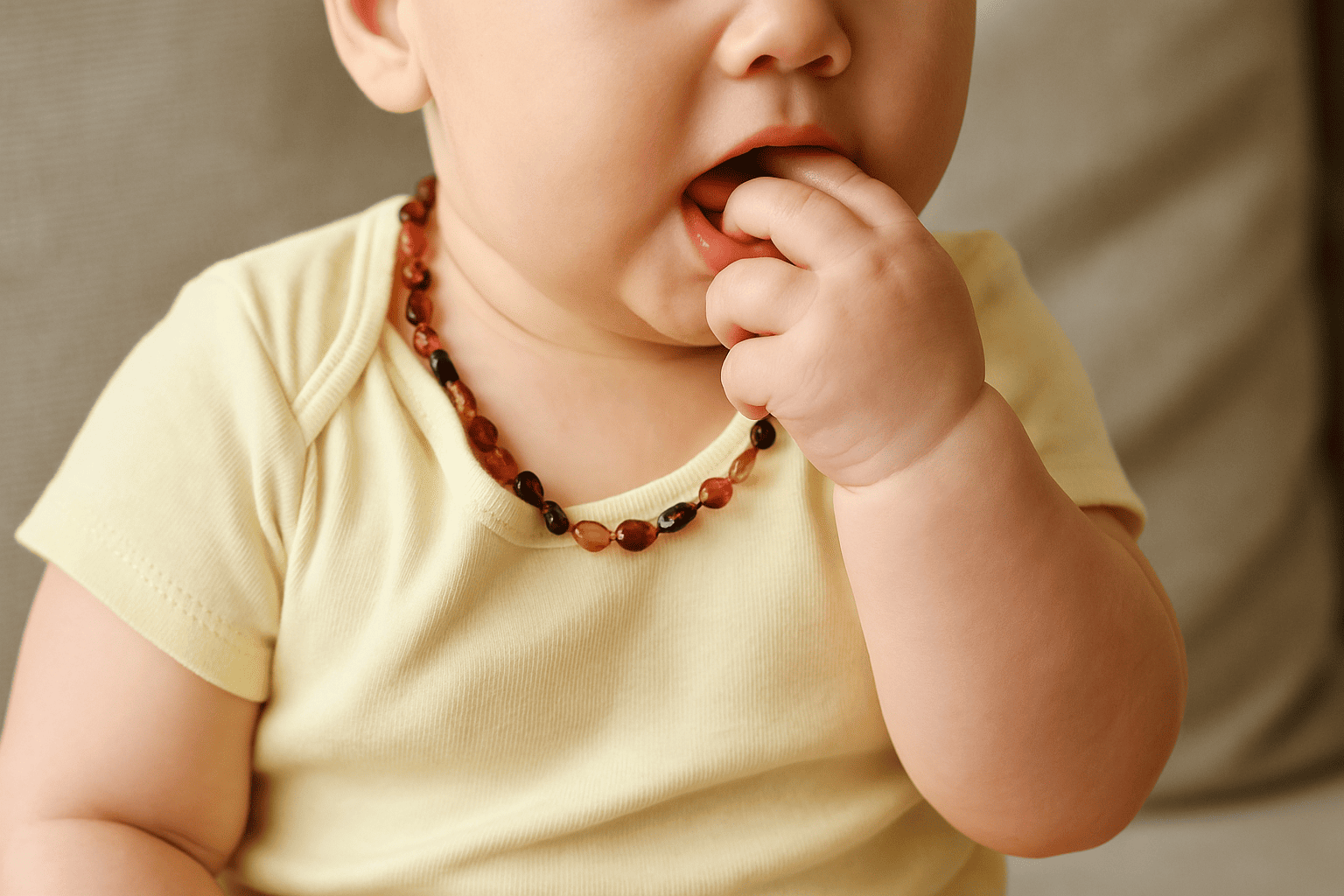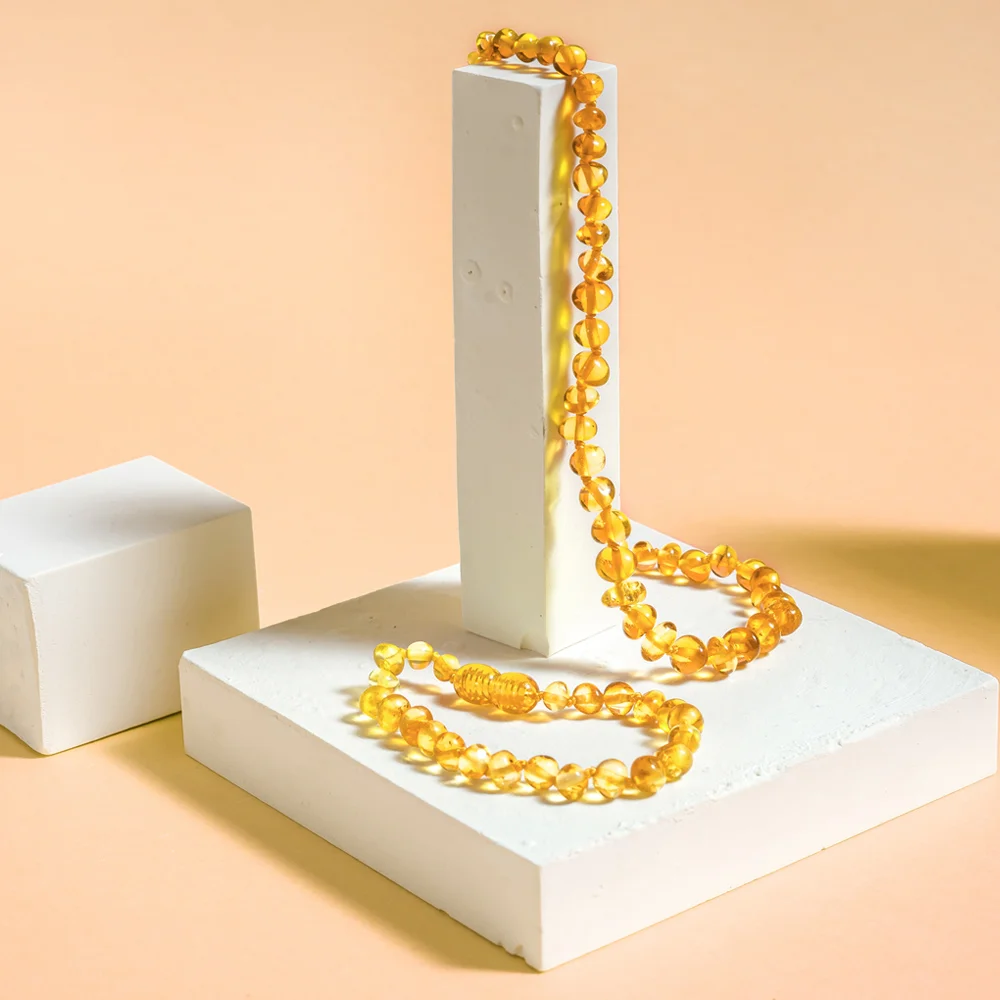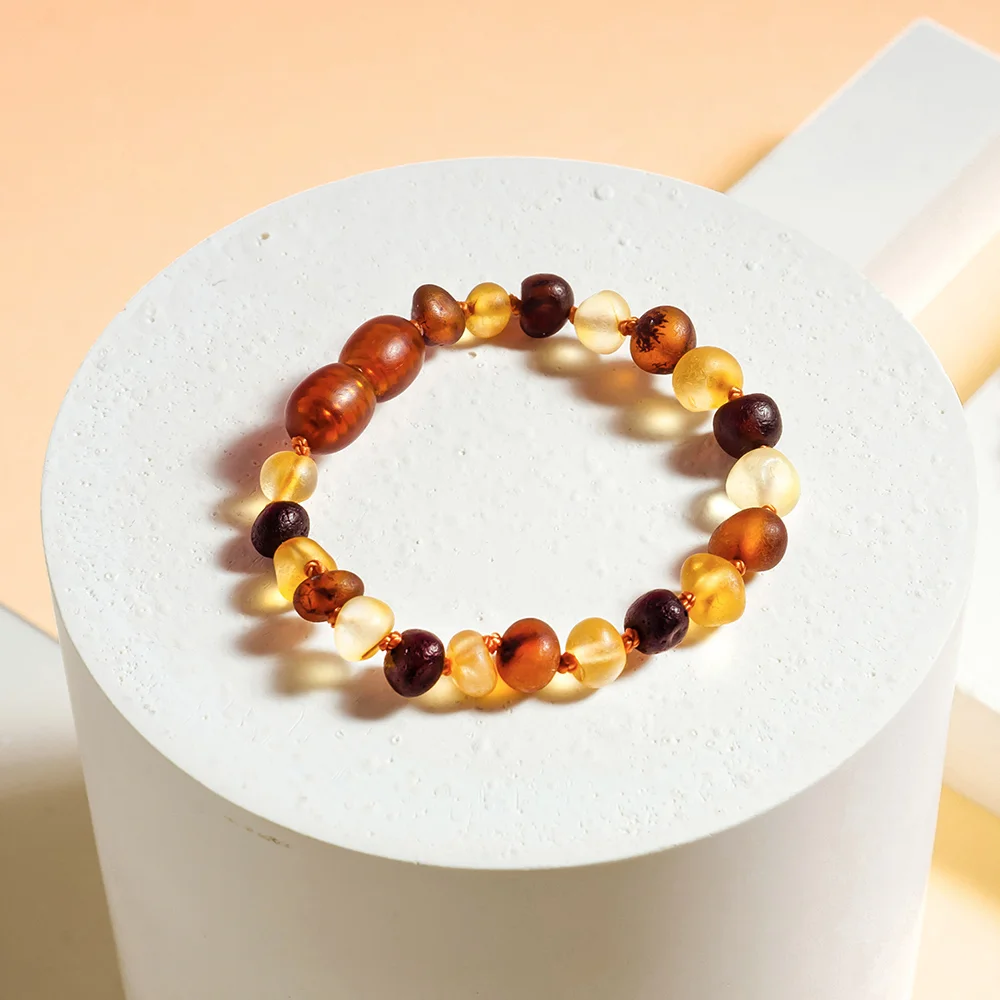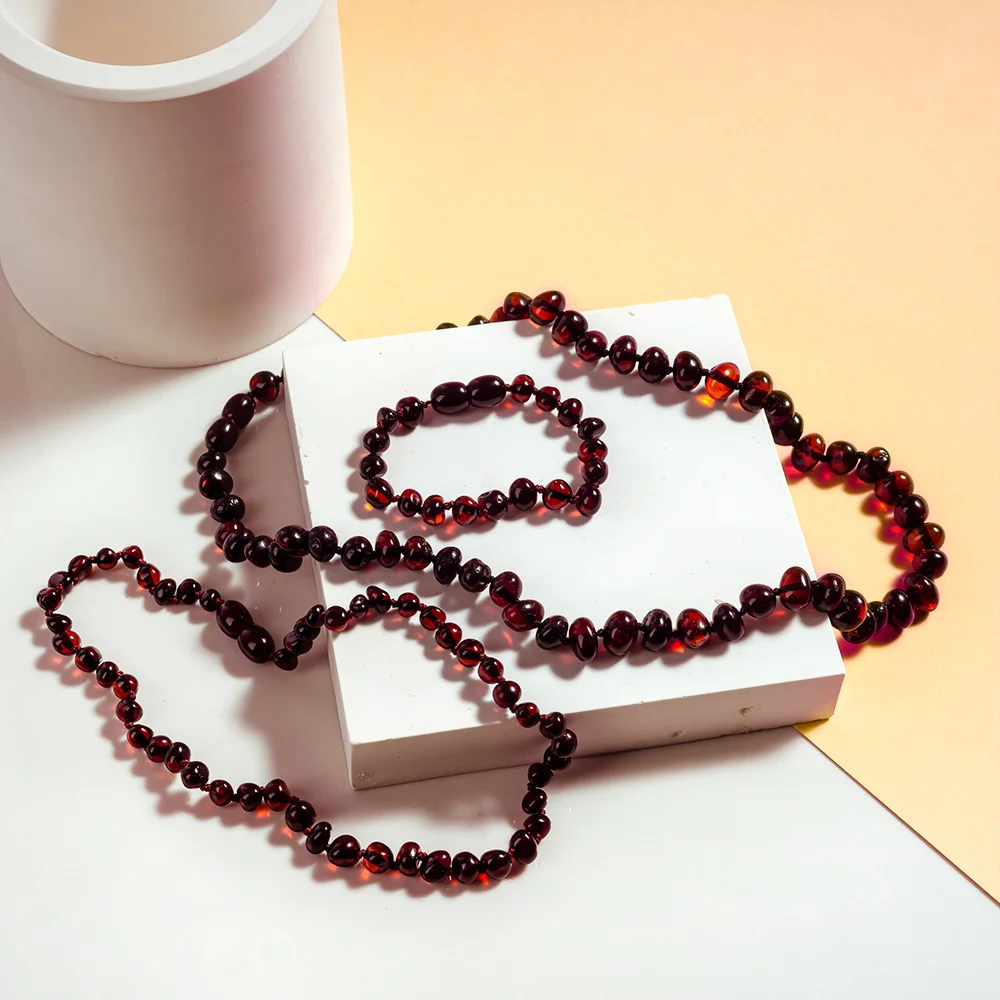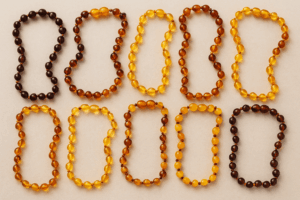Few parenting stages are as universally dreaded as teething. One day your baby is their cheerful, cooing self, and the next, it feels like you’ve got a tiny, frustrated roommate who can’t tell you exactly what’s wrong — only that something is. Their cheeks flush, fists end up in their mouth, and sleep (for both of you) becomes a rare luxury.
It’s a phase every baby goes through, yet it somehow still catches parents off guard. Maybe it’s because the process doesn’t just happen once. Teething is a slow marathon, unfolding over months — sometimes years — with each new tooth bringing its own wave of fussiness. In those long nights and drooly days, parents start looking for anything that might make their little one more comfortable.
That’s where amber teething necklaces often enter the conversation. These warm, honey-colored beads — often passed down through families or gifted to new parents — carry a mix of tradition, natural beauty, and the hope of gentle relief. They’ve been worn in some cultures for centuries, long before silicone teethers and refrigerated rings became part of the baby aisle.
But as with any baby product, especially one worn around the neck, safety and timing are everything. The big question is not just if you should try an amber teething necklace, but when your baby should wear it to get potential benefits while staying completely safe.
This guide will explore the tradition, the science (and debate), and the modern safety recommendations — so you can make an informed choice about when an amber teething necklace belongs on your baby and when it’s best left off.
Understanding Teething: Timeline, Symptoms, and Discomfort
Before deciding when your baby might wear an amber teething necklace, it’s worth understanding what’s really going on during teething.
For most babies, the first teeth begin to emerge somewhere between four and seven months old. These early arrivals are usually the bottom central incisors — the little “middle” teeth on the bottom gum line. From there, the process continues in waves: top incisors, lateral incisors, molars, and canines, until all 20 primary teeth are in place. By the time your child is around two to three years old, the teething chapter is complete.
But during that long stretch, each new tooth has to make its way through sensitive gum tissue. As the tooth approaches the surface, the gum can swell and feel sore, triggering a range of symptoms. You might notice your baby drooling more than usual, chewing on fingers or toys with intensity, becoming unusually fussy, or even resisting feeding when their mouth feels too tender.
Some babies barely react — their teeth seem to appear overnight with little drama. Others experience significant discomfort, disrupted sleep, and clinginess with every single tooth. For many parents, the unpredictability is one of the hardest parts. You can have a smooth week followed by three nights in a row of waking every hour, with no clear end in sight.
Teething itself isn’t an illness, but the discomfort it brings is real. And that discomfort is the reason parents explore various soothing options, from gum massages and chilled teething rings to natural remedies like amber necklaces. The goal is simple: to help your baby feel just a little better while this slow, inevitable process unfolds.
What Exactly Is an Amber Teething Necklace?
At first glance, an amber teething necklace might just look like a string of small, golden-hued beads. In reality, each bead is a piece of fossilized tree resin — some more than 40 million years old — carefully shaped and polished just enough to smooth rough edges while retaining its natural warmth. The most prized variety is Baltic amber, found in countries surrounding the Baltic Sea, where ancient forests once produced vast amounts of resin that hardened over millennia.
Unlike plastic or silicone teething products, amber necklaces aren’t meant for chewing. Instead, they’re designed to rest against your baby’s skin, typically around the neck but sometimes wrapped gently around the ankle or wrist. Supporters believe that body warmth encourages amber to release trace amounts of succinic acid, a naturally occurring substance in the resin that is thought to have mild anti-inflammatory or pain-relieving properties.
Amber comes in a surprising variety of colors — from pale honey and milky white to rich cognac and even deep cherry brown. Some beads are translucent, catching the light in golden glows, while others are opaque with tiny natural inclusions inside, like bubbles or flecks of ancient plant material. These imperfections aren’t flaws; they’re the signature of authentic amber, tiny time capsules from prehistoric forests.
The appeal of an amber teething necklace lies in its combination of beauty, tradition, and the possibility — however debated — of comfort for a teething baby. Parents who choose amber often value it as a keepsake just as much as a potential remedy, making it a unique item in the world of baby care.
The History and Tradition of Amber in Child Care
Amber’s story stretches far beyond modern parenting trends. For thousands of years, this “gold of the sea” has been traded, worn, and treasured across Europe and Asia. Archaeologists have discovered amber beads buried alongside children in prehistoric graves, suggesting that ancient families believed amber carried protective or healing powers.
In the Baltic region, where some of the world’s richest amber deposits are found, small amber charms were often given to infants as symbols of health and safety. Traders carried Baltic amber south along what became known as the Amber Road, a network of trade routes that connected the northern coasts to Mediterranean civilizations. In ancient Rome, amber was so valued that it was sometimes worth more than gold by weight.
The belief in amber’s protective qualities wasn’t limited to Europe. In parts of Asia, amber was used as a talisman to ward off illness or misfortune, and in Middle Eastern cultures, it was sometimes burned as incense during healing rituals. In many of these traditions, amber wasn’t just decoration — it was thought to carry the essence of life and nature itself, a warm, living connection to the earth.
When modern parents choose amber teething necklaces, they’re participating in a tradition that spans millennia. While the scientific reasoning may differ today, the symbolism remains: amber as a source of comfort, protection, and connection between generations. That historical weight is part of what makes deciding when and how to use amber such a personal choice for many families.
When Should My Baby Wear an Amber Teething Necklace?
The short answer: only when your baby is awake, supervised, and in a safe environment. While the idea of constant skin contact may sound appealing if you’re hoping for steady comfort, amber teething necklaces are not designed for 24/7 wear — and for good reason.
The safest practice is to think of the necklace as a daytime accessory rather than a permanent fixture. Many parents choose to put it on in the morning during playtime and remove it for all naps, bedtime, and times when their baby will be out of sight, even briefly. This includes car rides, stroller naps, and baby carrier walks if the parent isn’t directly watching the necklace area.
Some families use the necklace during the periods of the day when teething discomfort tends to peak — late afternoons or early evenings — while others have it on during all supervised waking hours. Whichever routine you choose, the guiding principle is simple: if you’re not there to see your baby at every moment, the necklace comes off.
Supervised daytime wear gives you the peace of mind that you can instantly respond if the necklace snags, loosens, or breaks. It also means you can check regularly to ensure it’s sitting comfortably against the skin without any irritation.
Why Sleep Is Off-Limits for Amber Necklaces?
If amber works through skin contact, wouldn’t wearing it overnight make sense? This is one of the most common questions parents ask — and one of the most important to answer clearly.
The reality is that any necklace worn by a sleeping baby carries a strangulation risk. Babies can shift position in their sleep, roll into bedding, or tuck their chins down in ways that cause the necklace to tighten. Unlike an older child or adult, they cannot free themselves if the necklace becomes caught.
There’s also the choking hazard. Even with individually knotted beads, a strong tug could break the string, releasing a bead into the crib. A bead that small could easily become a choking threat if it ends up in the baby’s mouth.
Health organizations, including the American Academy of Pediatrics and several European pediatric associations, strongly advise removing all jewelry from babies during sleep. These recommendations apply to teething necklaces, religious medals, and even “breakaway” safety clasps. No clasp or knotting technique eliminates the risk entirely.
For parents who still want the look or potential benefits of amber during nighttime, one safer alternative is to place the necklace around the ankle and cover it with a secure footed sleeper or sleep sack. Even then, most safety experts recommend removing the necklace altogether until morning, ensuring the sleep environment remains free of any cords, beads, or accessories.
The bottom line: nighttime is for safe, clear sleep spaces. If you’re using amber, keep it a strictly awake-and-supervised accessory — your baby’s safety is worth far more than any potential overnight comfort.
Choosing a Safe Amber Teething Necklace
If you’ve decided to let your baby wear an amber teething necklace during supervised times, the next step is choosing one that is well-made and genuinely safe. While no necklace can remove all risks, a carefully selected piece can greatly reduce the chance of problems.
The first thing to look for is authentic Baltic amber. Genuine amber comes from fossilized tree resin, not plastic or resin imitations. Real amber feels warm to the touch, is lightweight, and may have small imperfections or inclusions inside. Reputable sellers will provide information about the source of their amber and may even include a certificate of authenticity.
Necklace length is another crucial factor. It should be short enough that your baby cannot lift it into their mouth, but not so tight that it presses uncomfortably against the neck. Most amber teething necklaces for infants are between 11 and 13 inches long — long enough to drape naturally, short enough to stay out of the mouth.
Check how the beads are secured. The safest designs feature individually knotted beads, meaning if the string breaks, only one bead will come loose rather than the entire strand. The clasp should also be designed with safety in mind. Screw clasps are common for their security, but breakaway clasps can add an extra layer of safety if the necklace is pulled too hard.
Finally, consider the shape and smoothness of the beads. Rounded beads are less likely to cause skin irritation, and polished or semi-polished surfaces feel gentle against delicate skin. Avoid necklaces with sharp edges, irregularly drilled beads, or loose fittings — these can create discomfort or hazards.
A safe amber necklace is one that’s authentic, well-sized, sturdily made, and sourced from a seller who prioritizes both quality and transparency.
Caring for Amber Jewelry
Amber is beautiful but surprisingly delicate compared to gemstones like quartz or sapphire. It ranks only 2 to 2.5 on the Mohs hardness scale, which means it can scratch, dull, or even crack if not handled with care. Proper maintenance will keep your amber necklace looking warm and vibrant for years.
Cleaning should always be gentle. Wipe the beads after each wear with a soft, dry cloth to remove skin oils and residue. If the necklace needs a deeper clean, use lukewarm water with a tiny drop of mild soap. Dampen a soft cloth with the soapy water and wipe each bead, then rinse with a clean, damp cloth. Avoid soaking the necklace — prolonged water exposure can weaken the string and dull the amber’s surface.
Keep amber away from harsh chemicals like perfumes, hairsprays, or cleaning products, as these can cloud the surface. Similarly, avoid exposing it to extreme heat, such as leaving it in a hot car or using a hairdryer near it, as heat can cause cracks.
When the necklace isn’t in use, store it separately in a soft pouch or lined jewelry box to prevent scratches from harder items. If the amber starts to look dull over time, a tiny drop of olive or almond oil rubbed in with a soft cloth can help restore its shine — just be sure to buff away any excess oil so it doesn’t transfer to clothing.
A little care goes a long way. With mindful handling, your amber necklace can remain both a functional teething accessory and a keepsake worth passing down.
The Science and Debate Around Succinic Acid
At the heart of the amber teething necklace discussion is one key claim: that amber contains succinic acid, and that when worn against warm skin, trace amounts may be absorbed into the body, potentially offering pain relief and calming effects.
Succinic acid is a naturally occurring substance found not just in amber but also in certain foods, plants, and even in the human body as part of our natural energy cycle. It has been studied for its possible anti-inflammatory, analgesic (pain-relieving), and antioxidant properties. In theory, if a baby wears amber beads against the skin, body heat could release minute amounts of succinic acid, which might then be absorbed through the skin to help soothe teething discomfort.
However, the scientific consensus is still unclear. Most research on succinic acid involves its effects in laboratory or medical contexts — not specifically amber jewelry on babies. There’s limited evidence proving that the amount of succinic acid released from amber in typical wear conditions is enough to have a measurable effect. Some scientists even question whether skin absorption is possible in quantities that would impact pain or inflammation.
On the other hand, parental reports tell a different story. Many parents claim they notice reduced fussiness, better sleep, or less drooling when their baby wears amber consistently during supervised daytime hours. While this could be due to a placebo effect (in parents) or coincidental timing in the teething process, these anecdotes are a big part of amber’s ongoing popularity.
Supporters also point to amber’s centuries-long history in European and Baltic cultures, where it was valued for more than just teething relief — as a general protective talisman for children. Skeptics argue that tradition alone isn’t proof, but it does show that amber’s reputation spans far beyond recent marketing trends.
The takeaway is this: while the science hasn’t confirmed amber as a medical treatment for teething, it remains a natural, non-invasive, and culturally rooted option that many parents choose for aesthetic, traditional, or anecdotal reasons. The key is to use it mindfully and safely, understanding both its potential and its limits.
Amber Necklaces as Keepsakes and Cultural Symbols
For many families, an amber teething necklace becomes more than just a baby accessory. Even if it’s originally purchased for its potential soothing properties, it often turns into a keepsake — a tangible reminder of a child’s earliest years. Some parents tuck it away in a memory box alongside hospital bracelets, first shoes, and birthday cards, preserving it as a small piece of their baby’s story.
Amber also carries a sense of continuity. In parts of Eastern Europe and the Baltic region, it’s not unusual for amber jewelry to be passed down through generations. A necklace worn by a mother or grandmother might be gifted to a new baby, linking family history with tradition. In these cases, the value is as much emotional as it is material.
Even outside regions where amber has deep cultural roots, parents often find meaning in its natural origins. Each bead is a fragment of ancient history, formed from the resin of prehistoric trees and fossilized over millions of years. Holding it in your hand feels different from holding a mass-produced baby item; it’s warm, irregular, and unique, with tiny patterns or inclusions that no other piece will ever share.
For some, amber becomes part of a personal parenting style — a nod to holistic, nature-inspired approaches. For others, it’s simply a beautiful, sentimental memento of a fleeting stage of life. In either case, the emotional connection is real, and it’s one reason amber teething necklaces continue to appear on baby registries and in gift boxes, long after a child has finished teething.

